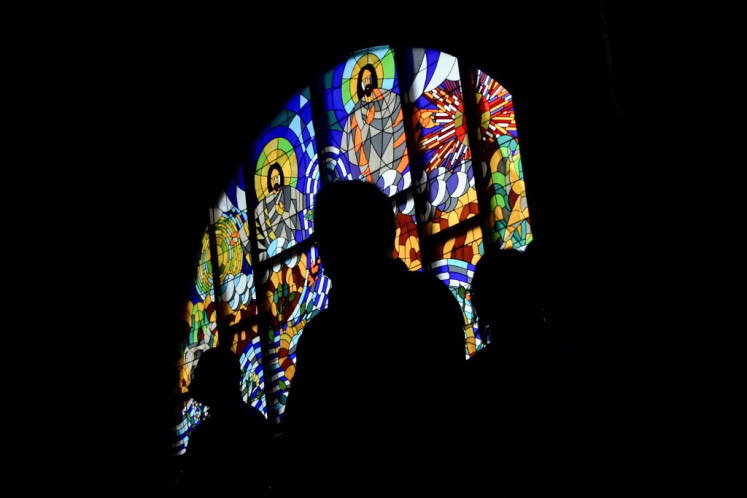Popular Reads
Top Results
Can't find what you're looking for?
View all search resultsPopular Reads
Top Results
Can't find what you're looking for?
View all search resultsDivine inspiration: Seeing Jesus through artists’ eyes
Jesus of Ubud: Ketut Lasia’s painting, Yesus Mengajar Murid-Muridnya (Jesus Teaches His Disciples), depicts Bibical narratives in a Balinese setting
Change text size
Gift Premium Articles
to Anyone
J
esus of Ubud: Ketut Lasia’s painting, Yesus Mengajar Murid-Muridnya (Jesus Teaches His Disciples), depicts Bibical narratives in a Balinese setting.(Courtesy of Ketut Lasia)
One painting shows Jesus born in Bali, while another painting recounts the moment Jesus visited rural Yogyakarta. The paintings are not historically or biblically accurate, but they capture Indonesian Christian artists’ feelings and admirations about their savior.
German theologian Karl Rahner once said, “whoever wishes to know Jesus, for instance, should visually recognize the figure of Jesus.”
Rahner, one of the most influential Roman Catholic theologians of the 20th century, affirmed that understanding esthetic symbols constituted the “most jubilant path” that led to a more profound religious experience.
For centuries, artists around the globe have depicted Jesus based on their own feelings, thoughts and backgrounds. This has created a rich diversity of Jesus’ depictions in paintings, sculptures, plays and other artistic works.
In the eyes of a handful of Indonesian artists, Jesus is the savior who lived close to their hometowns.
Ketut Lasia, a Balinese painter who converted to Christianity, portrays Jesus as being born in the serene Ubud, in the uplands of Bali. Mary and the three wise men (Caspar, Melchior and Balthazar) are painted as Balinese people clad in traditional clothes.
Likewise, the late Surabaya, East Java, painter Tedja Suminar pictured a Malay-faced Jesus playing with several tourist children on Sanur Beach in Bali.
In his semi-abstract piece, renowned choreographer and painter Bagong Kussudiardja pictured Jesus with the background of farmland in Sleman, Yogyakarta.
Painters Sudjojono, Aming Prayitno and Subroto SM have also shared their views of Jesus through their semi-abstract works.
“The important thing is the character and spirit of Jesus can be felt in my works,” said Klaten-born artist Subroto.
In Remy Sylado’s musical drama Yesus Sang Penebus (Jesus the Redeemer), Jesus has a Malay-Tegal face and takes a ride on a becak (pedicab).
“After the Ascension, Jesus should be theologically described instead of anthropologically,” Remy suggested.
The presence of Jesus provides an all-embracing inspiration for artists, covering not only his birth but also all traces of his life.
The events in which he healed the sick, delivered the Sermon on the Mount, had the Last Supper and was crucified are variedly represented and filled with the personal expressions of individual artists.
The depictions of Jesus in art evolve responding to the artistic developments of each era.
In anthropological discourses and thousands of classical paintings, Jesus had always been pictured with a Jewish profile.
Artists of the 17th century, such as Italian sculptor Bernini and painters El Greco and Caravaggio, showed Jesus in an adoring view; a handsome man with long hair, a serious-looking face, patient and a graceful body. But as the modern era arrived, such patterns of veneration swiftly changed.
Inspired by his time in Tahiti, French painter Paul Gauguin in 1889 created Ia Orana Maria (Hail Mary), portraying Mary and Jesus as Tahitians. Mary is dressed in a red cotton pareu with a floral pattern.
“Jesus is a spirit. The body of Jesus merely functions to account for his existence,” said Gauguin.
Spanish surrealist painter Salvador Dalí presented The Madonna of Port Lligat (1949-1950), which consists of two paintings with both depicting a seated Madonna (posed by Dalí’s wife, Gala) with the infant Christ on her lap. The paintings feature surrealist details such as fish, seashells and a rhinoceros.
Shanghai-based painter Yu Jiade used the Chinese ink brush painting style in depicting the meeting of Jesus with a Samarian woman.
Meanwhile, British artist Stanley Spencer and Fernando Botero of Colombia have created quirky depictions of Jesus by always rendering the figure in stout proportions.










